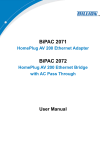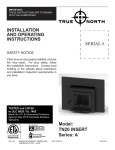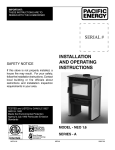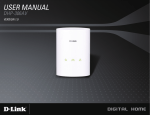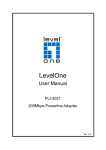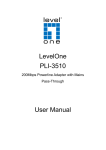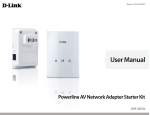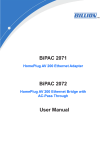Download BEC BEC 2072 User manual
Transcript
BEC 2071 HomePlug AV 200 Ethernet Adapter BEC 2072 HomePlug AV 200 Ethernet Bridge with AC Pass-Through User Manual Table of Contents Product Introduction .....................................................................................3 Features & Specifications .............................................................................3 Getting Started ...............................................................................................5 Features - HomePlug AV 200 Ethernet Bridge .................................................... 5 Hardware Overview ........................................................................................... 6 Sync Button Function:................................................................................. 8 HomePlug AV 200 Application Scenarios:................................................... 8 Application Illustration...............................................................................10 BEC 2071 (2072) Utility Installation Procedures........................................ 11 Microsoft .NET Framework 2.0 Installation ......................................................13 BEC 2071 (2072) Utility Installation .................................................................16 Starting BEC 2071 (2072) Utility..................................................................19 Understanding BEC 2071 (2072) Utility............................................................20 Main Tab....................................................................................................20 Password Setup Procedure:............................................................22 Add New HomePlug Device to a Powerline Network ...................23 Privacy Tab ................................................................................................24 Diagnostics Tab..........................................................................................26 About Tab ..................................................................................................28 Troubleshooting...........................................................................................29 Product Introduction BEC 2071 / 2072 is a networking device that utilizes the existing wiring system as a path to transmit data signal through the inter-conversion between digital and analog signal. With this functionality, BEC 2071 / 2072 can be plugged into an electrical socket to draw power and at the same time establishing a network connection between two or more Ethernet devices. The BEC 2071 / 2072 can be used to bridge any Ethernet device to your Powerline network in your home or office. With this technology, Ethernet devices in your home or office can equally share high speed data transmission rate without the need to spend excessive time and money installing expensive Ethernet cable. It can be plugged into an Ethernet port on a router to equip a network with Powerline capabilities and take advantage of the router features. The BEC 2071 / 2072 can also be plugged directly into a cable or DSL modem that allows instant internet access over home Powerlines to each computer equipped with a HomePlug AV certified Powerline network adapter. BEC 2071 / 2072 makes high-speed modem sharing as fast and simple as plugging the devices in the wall. Features & Specifications Protocol TDMA, CSMA/CA Standard Ethernet specification: IEEE 802.3, IEEE 802.3x, IEEE 802.3u, Auto MDI/MDIX Transmission speed 200Mbps Optimal Coverage Range 200M Modulation Supports OFDM - 1155 carriers,1024 / 256/64 QAM, QPSK, BPSK and ROBO Frequency Band 2MHz ~ 30MHz Security 128-bit AES encryption over household power supplier grid Device port Ethernet RJ-45 Operation System • Windows 98_SE / Me / 2000 /XP(32 and 64 bit)/ Vista (32 and 64 bit) RAM 128Mb Power Supplier • Input: 100~240V AC, 50~60Hz Specification Physical Interface • Interface: Ethernet 10/100M (MDI/MDIX) switch • Sync button • Reset button • Power AC Plug (for BEC 2071 only) • Power AC socket (for BEC 2072 only) • LED display: - 1.0 DET LED - POWER LED - PLC (Powerline Link/Act) LED - ETH (Ethernet Link/Act) LED Dimension BEC 2071: 112.35 X 77.70 X44.50 mm BEC 2072: 165 X 73 X 38.50 mm Power Saving Reduce power consumption by at least 60% during power saving mode. Operating Temperature / Humidity • Operating temperature: 0 ~ 400C • Storage temperature: -20 ~ 700C • Humidity: 5~95% non-condensing Getting Started Safety Warnings 1. Do not use the adapter in high humidity or high temperature environment. 2. Do not open or repair the case yourself. 3. Avoid using this product and all its accesories outdoor. 4. 5. Place the adapter on a stable surface. Only “HomePlug AV” compliant Powerline Communication (PLC) adapter for remote access is necessary. Features - HomePlug AV 200 Ethernet Bridge 1. 2. 3. 4. 5. 6. 7. 8. 9. Physical layer data rate up to 200Mbps over existing Powerline. Uses powerline technology that takes advantage of the unused bandwidth of the electrical wiring in the home. Ideal for Triple Play applications such as IPTV, VoIP telephony and high-speed Internet access. Support 10/100 (MDI/MDIX) Ethernet switching. Compliant with the HomePlug Powerline Alliance Industry specification HomePlug AV. Power supplier design inside. Ideal for Residential Users. Power Saving mode: When PC or other Ethenet devices are completely power off, BEC HomePlug device will automatically enter power saving mode which will help to reduce power consumption by at least 60%. Noise Filter (only available in BEC 2072): Allow the filtering of noise which may be generated by some electrical appliances such as vacumn cleaner and hair dryer to prevent possible interference with HomePlug AV network. Hardware Overview BEC 2071 BEC 2072 1.0 DET LED Power LED PLC LED AC Outlet / AC Pass-thru (only available in BEC 2072 model) ETH LED Sync Button Reset Button Ethernet Port Power Plug The Description of each labeled part is described in the table below. AC Outlet / AC Pass-thru Enable the plugging in of another Ethernet device for (only available in BEC direct power supply. The AC Pass-thru allows the filtering of noise to 2072 model) prevent HomePlug AV Network interference. Note: The AC Outlet only support devices that use 6A (maximum) electric current. 1.0 DET LED Blink when detect the presence of other HomePlug 1.0 devices that have the transmission rate of 14 or 85 Mbps. Note: Due to the incompatibility of HomePlug AV 200 with HomePlug 1.0 devices, the presence of the HomePlug 1.0 devices within the powerline network will thus reduce the performance of your powerline network. Power LED Lit when the device is power on. PLC (Powerline Link/Act) Lit when a network has been established. Blink when powerline data is transmitted or received. LED ETH (Ethernet Link/Act) Lit when an Ethernet data signal is transmitted or LED received. Sync Button Used to establish a LAN network with other Ethernet devices. Reset Button Press this button to restore the device configuration to factory default. Ethernet Port Connect the HomePlug AV device with an Ethernet device (eg. PC or modem router) with the Ethernet cable included. Power Plug / AC Power Plug into an electric socket to draw power and to form a powerline network with other HomePlug AV Cord devices. Sync Button Function: There are 3 types of Sync Button trigger states: 1. Broadcast State: A BEC 2071 / 2072 device can provide information for another BEC 2071 or 2072 device to join its powerline network group (works even if it is currently the only device existing within the network group). 2. 3. Join State: For an ungrouped BEC 2071 or 2072 device to join an existing powerline network group. Press the Sync Button on the first BEC 2071 / 2072 device to turn it to Broadcast State. Then press the Sync Button of an ungrouped BEC 2071 / 2072 device to turn it to a Join State. 4. Ungroup State: Press the Sync Button for more than 10 seconds to separate the device from its current attached network group. HomePlug AV 200 Application Scenarios: Scenario 1: A BEC 2071 / 2072 device A wants to form a network group with another BEC 2071 / 2072 device B. You can allocate whichever device (A or B) to be the Broadcast State and the Join State. Example: 1. Hold down the Sync Button of device A for 1~3 seconds to turn it into Broadcast 2. 3. State. Hold down the Sync Button of device B for 1~3 seconds to turn it into Join State. Wait for the Sync LED of both devices to light up then you will now have both devices being in the same network group. Note: Once the device is plugged into the electric socket, connect it with an Ethernet cable within 60 seconds to prevent the device from Auto Power Off. Scenario 2: A BEC 2071 / 2072 device wants to join an existing network group BC Device A wants to join a network group “BC” currently consisting of device B and device C. Any devices within the “BC” group can become the “Broadcast State” and device A will be the “Join State”. Example: 1. Hold down the Sync Button of device B or C of the BC network group for 1~3 seconds to turn it into Broadcast State. 2. 3. Hold down the Sync Button of device A for 1~3 seconds to turn it into Join State. Wait for the Sync LED of both devices A and (B or C) to light up then you will now have device A join the BC network group. Note: Once the device is plugged into the electric socket, connect it with an Ethernet cable within 60 seconds to prevent the device from Auto Power Off. Scenario 3: A BEC 2071 / 2072 device A of network group AD wants to join an existing network group BC. For a device which already belongs to a network group is to join with a different network group, that device has to be ungrouped from its current attached group first. 1. 2. 3. 4. Example: Hold down the Sync Button of device A for more than 10 seconds to ungroup it from network group AD. Then hold down the Sync Button of device (B or C) of network group BC for 1~3 seconds to turn it to Broadcast State. Hold down the Sync Button of device A again for 1~3 seconds to turn it to Join State. Wait for the Sync LED of both devices A and (B or C) to light up. Now you will have device A join the network group BC. Note: Once the device is plugged into the electric socket, connect it with an Ethernet cable within 60 seconds to prevent the device from Auto Power Off. Application Illustration Home / Office Setting BEC 2071 (2072) Utility Installation Procedures 1. Place the BEC 2071/BEC 2072 auto-installation CD into CD-ROM/DVD-ROM drive and click on Utility for Easy Installation. your 2. If you have not installed Microsoft .NET Framework 2.0, click on Install Microsoft .NET Framework 2.0 to install this program first before installing BEC 2071 (2072) Utility. 3. 4. If you have already had Microsoft .NET Framework 2.0 installed, please click on Install the utility for Windows (32-bit / 64-bit) and proceed to the section on BEC 2071 (2072) Installation. If you are using Windows Vista operating system, do not have to install Microsoft .NET Framework 2.0. Simply click on Install the utility for Windows (32-bit / 64-bit) and proceed to the section on BEC 2071 (2072) Installation. Microsoft .NET Framework 2.0 Installation 1. After clicking on Install Microsoft .NET Framework 2.0, the Net Framework 2.0 installation wizard will be displayed. 2. Click to proceed with the installation. 3. Check the Agreement acceptance box then press Install to start the installation. When the installation is complete, click Finish to exit. BEC 2071 (2072) Utility Installation 1. After clicking on Install the utility for Windows (32-bit / 64-bit), the installation wizard will appear. Click 2. You may define the location of the installation folder using the Browser or use the default location. In addition, you can also choose to install BEC 2071 (2072) Utility only for yourself or for all the users who share your PC. When all necessary items are properly selected, press to proceed. 3. Press to confirm and start the installation. 4. Wait until the installation process is complete then press complete the utility setup. to Starting BEC 2071 (2072) Utility Once the BEC 2071 (2072) Utility Setup Wizard is installed, a shortcut will appear on the desktop. You can start the BEC 2071 (2072) Utility by double clicking on the shortcut, or go through “start”→ “All Program”→ “BEC 2071 (2072) Utility” →“BEC 2071 (2072) Utility”. Understanding BEC 2071 (2072) Utility BEC 2071 (2072) Utility consists of 4 screens accessed through 4 panel tabs. The 4 panels are Main, Privacy, Diagnostics and About located on the top left corner of the program for configuration convenience. Main Tab The Main Tab Screen lists all the powerline devices connected to the host computer when the utility is running. The top panel shows all local HomePlug devices connected to the computer’s NIC (Network Interface Card). Normally, only one device will be seen. If there is more than one local device being connected (eg. USB / Ethernet adapter), user can select the local device by clicking on it and then click the Connect button to its right. The status area above the button indicates that your PC is connected to that same device. Once connected to the local device, the utility will automatically scan the power line periodically for other newly connected HomePlug devices. If no local HomePlug devices are discovered, the status area above the connect button will indicate with a message ‘NO HOMEPLUG ADAPTERS DETECTED’. The lower panel displays all the HomePlug remote devices, detected on the current network. The total number of remote devices connected on the same network can be found on top of the Remote device panel. The Network type (Public or Private) is also displayed based on the network status of the local device. The scan status option is displayed on the top right corner above the Remote devices panel showing whether the Autoscan function is turned ON or OFF. The following information is displayed for all devices that appear in the lower panel: Device Name: Show the default device name. User can change the name by either clicking on the rename button or by clicking on the name and editing in-place. An icon is usually shown with the device name. Password (*required when creating a private network) This column is left blank by default. The password will be displayed only after it has been created. For detail information on password setup, please refer to section on Password Setup Procedure. Rate (Mbps): Display the data transmission rate of each device. MAC Address: Show the Remote device MAC address. Quality: Display the overall quality of the data transmission rate. When the transmission rate is good, the number of line appear will increase. Password Setup Procedure: 1. To assign a password to a specific device, select the device and click on the Enter Password button at the bottom of the lower panel to call up the Set Device Password dialog box. 2. Then type in the password in the blank provided and press OK. Note: The Password field accepts the Device password in any case formats, with or without dashed between them. 3. If the password entered is not recognized or unacceptable, an error message box will pop up prompting user to change the password. Add New HomePlug Device to a Powerline Network Additionally, when there is more than one powerline network present, a new HomePlug device can be added to any specific powerline network as desired. To add a new device to a network: 1. 2. Press the Add button. When a Add Device to Network dialog box pops up, enter the name and the password of the device to be added to the network in the blank provided then press OK. Privacy Tab Privacy Tab is to allow user the convenience to manage the security of the private powerline network and to enable the adding of new HomePlug device to the private network. All HomePlug devices are shipped using a default logical network name “HomePlugAv”. The Privacy tab screen allows user to change its default public network type to a private network by changing the network name (network password) of devices. The user can always reset the network type to HomePlug network (Public) by entering “HomePlugAv” as the network name or by clicking on the Use Default button. Note: Changing the network name to anything other than HomePlugAv will show the network type on the main screen as Private. Set Local Device Only button can be used to change the network name (network password) of the local device. If a new network password is entered, all associated devices seen on the Main Tab prior to this will be no longer present in the new network, rendering the local device unable to communicate with other devices in its previous network. Set All Devices button is used to change the logical network of all devices that appear on the Main tab screen whose Device Password had been entered for the same logical network. A dialog window will appear to report the success of this operation. For devices whose device passwords were not entered, this operation will fail and will report a failure message. Diagnostics Tab The Diagnostics Tab screen shows System information and a history of all remote devices seen over a period of time. This screen is available for OEM/ODM Customization. The Upper panel shows technical data concerning software and hardware present on the host computer which were used for communication via HomePlug device on the Powerline network. The data includes the following: • Operating System Platform/Version • Host Network Name • User Name • MAC Address of all NICs (Network interface card) connected to the host • Identify versions of all Driver DLLs and Libraries used (NDIS) and optionally • MAC Firmware Version • MAC addresses of all devices connected locally to the host • Version of the Configuration Utility • Vendor name • Microprocessor The Lower panel contains a history of all remote devices seen on the computer over a certain period of time. All devices that were on the powerline network are listed here along with a few other parameters. Devices that are active on the current logical network will show a transfer rate in the Rate column; devices on other networks, or devices that may no longer exist are shown with a “?” in the Rate column. The following remote device information is available from the diagnostics screen: • Device Alias Name • Device MAC Address • Device Password • Device Last known rate • Device Last Known Network name • Vendor name • Date device last seen on the network • MAC Firmware version • Number of dropped connections • Number of loss connection • The highest transmission rate recorded • The lowest transmission rate recorded • Total data sent The diagnostics information displayed may be saved to a text file for later use, or can be printed for reference for a technical support call. Devices, which are not part of the network anymore, can be deleted using the delete button. A dialog window pops up with a confirmation message if we try to delete a device whose password has been entered. About Tab The About screen shows the software version and provides the HTML link to the BEC official website. Clicking on the web address field will open a web browser that link directly to the web site. Under the Preferences panel, user can check the AutoScan box to turn on the Auto Scan function or check off the box to turn off the Auto Scan function. Troubleshooting Problem: My Homeplug device is unable to detect my other HomePlug device. Solution: This may due to the accidental change of the device password. Access the HomePlug AV Utility and select the Privacy Tab. Enter the password “HomePlugAV” (Case Sensitive) in the blank provided. Then press the “Set to Local Device Only” button. Repeat the same procedure to the other HomePlug device.





























